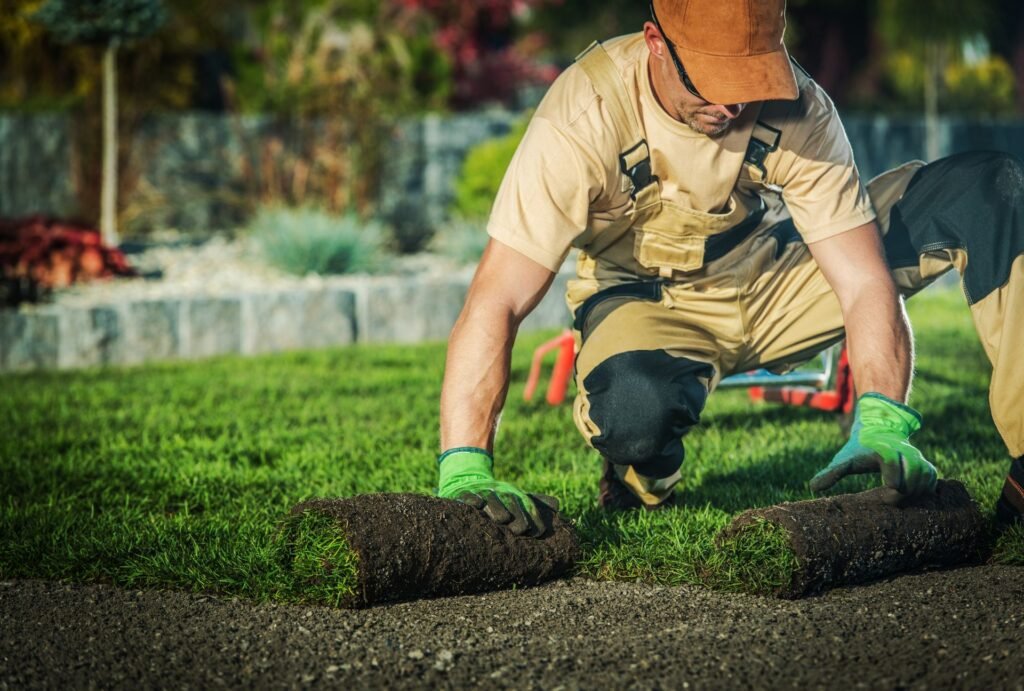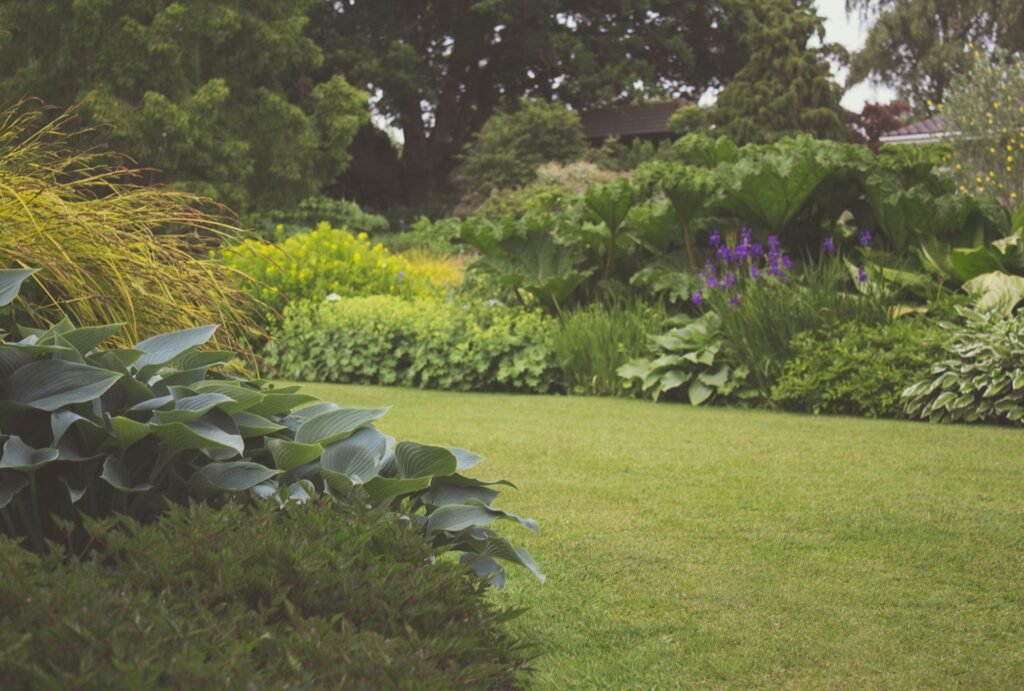Welcome to the world of sustainable boundary landscaping where eco friendly design meets functionality and beauty. As we become more aware of the environmental challenges we face more people are looking to bring their outdoor spaces into harmony with nature and boundary landscaping is a big part of that. By designing your property boundaries with sustainability in mind we can create vibrant low maintenance landscapes that support biodiversity, conserve resources and privacy. Whether you’re a homeowner, gardener or just interested in eco friendly practices this guide will give you practical tips and ideas to turn your boundaries into thriving sustainable spaces.
Boundary landscaping is designing your property borders using eco friendly practices to support biodiversity, conserve resources and create functional beautiful spaces. Key elements are planting native species, water efficient systems, edible plants and soil health through composting and mulching. It’s good for the environment and reduces maintenance and supports local wildlife.
Table of Contents
What Is Sustainable Boundary Landscaping?
Definition: Sustainable boundary landscaping is the designing and maintenance of landscape boundaries – fences, hedges, walls or plantings – in a way that has minimal impact on the environment and supports biodiversity. It’s about choosing materials, plants and techniques that are good for the local ecosystem, long term environmental balance and functional outdoor spaces.
The main aims of sustainable boundary landscaping are:
- Reduce resource use: Using renewable, recyclable or locally sourced materials to reduce the footprint.
- Biodiversity: Integrating native plants and habitats for local wildlife, from birds to pollinators, to create a balanced ecosystem.
- Water conservation: Choosing plants that need less water and using techniques like rain gardens or permeable surfaces to manage stormwater.
- Low maintenance: Strategies that reduce the need for excessive maintenance, fertilisers or pesticides, so the landscape can be self sustaining.
Why it Matters: Sustainable boundary landscaping is important in the environmental sense but also has social and economic benefits so it’s worth it for property owners and communities.
- Environmental Benefits:
- Reduce Carbon Footprint: By using local and low impact materials like sustainably sourced timber or recycled materials and minimising energy use through design the boundary landscaping can reduce greenhouse gas emissions. For example low maintenance plants reduce the need for frequent mowing which reduces fuel consumption and emissions from equipment.
- Improve Soil Health: Sustainable landscaping practices like planting cover crops or using organic mulches promote healthy soil ecosystems. Healthy soil retains water, reduces erosion and supports plant growth which in turn absorb more carbon dioxide from the atmosphere.
- Social Benefits:
- Improve Property Aesthetics: Sustainable landscaping often includes natural elements like native plants which add beauty, variety and texture to boundary areas. This improves the overall look of the property and creates a welcoming and visually pleasing environment for homeowners, visitors and passersby.
- Community Harmony: Well designed boundary landscapes can improve community engagement by creating shared spaces like community gardens or green buffers that bring the community together. Sustainable landscapes create environments that value natural beauty and serenity which benefits residents’ wellbeing.
- Economic Benefits:
- Long term cost savings: A well designed sustainable landscape can save property owners money in the long run. Using low maintenance plants, drought tolerant species and natural materials reduces ongoing maintenance costs – water, fertiliser and labour. For example once established native plants require less water and care than non native alternatives so lower utility bills and gardening costs.
- Increased property value: Sustainable boundary landscaping adds value to a property by improving its overall look and environmental credentials. Homes with eco friendly low maintenance landscapes are becoming more and more desirable as more buyers look for properties that align with sustainable living.
Sustainable boundary landscaping is a long term solution to reducing our environmental footprint and creates a greener, healthier and more harmonious living space.
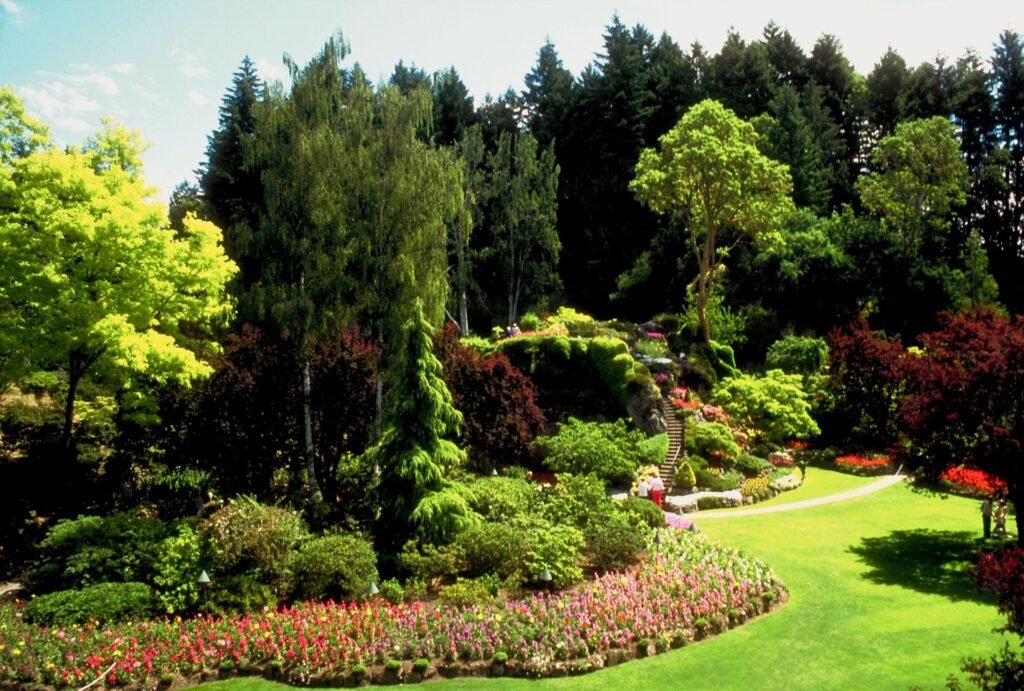
Key Principles Of Boundary Landscaping
Sustainable boundary landscaping is important for environmental health, resource conservation and outdoor space aesthetics. When designing your landscape focus on key principles like native plant selection, soil health, water conservation and biodiversity and you will make a big difference. Below we go into more detail on these principles to help you create a boundary that thrives with the environment.
Native Plant Selection
Native plants are the way to go for boundary landscaping in New Zealand. They are naturally adapted to the climate so are more resilient and easier to maintain. By choosing native species you will create a landscape that needs less water, less pesticides and minimal fertiliser which reduces your environmental footprint.
Benefits of Native Plants:
- Resilience: Native plants are adapted to local conditions, soil, rainfall and temperature fluctuations. So they need less watering and can withstand the seasons better than non native species.
- Less Water: Many native plants are drought tolerant, perfect for areas that are dry or water restricted. They have deep roots that can access water deeper in the soil.
- Support for Local Wildlife: Native plants provide food and shelter for local birds, insects and other wildlife, biodiversity in your garden. By choosing the right plants you can create a haven for pollinators like bees and butterflies which are essential for many ecosystems.
Native Plants for New Zealand’s Climates:
- Kāwā (Pseudopanax arboreus): A versatile shrub or small tree for coastal or windy areas.
- Harakeke (Phormium tenax): Great foliage, wet or dry conditions, good for many landscapes.
- Rātā (Metrosideros spp.): Resilient species for well draining soils, bright red flowers that attract birds.
- Tōtara (Podocarpus totara): Large evergreen tree for boundary hedges or windbreaks in rural and urban areas.
Soil Health and Composting
Healthy soil is the base of any sustainable garden. Improving soil fertility through composting and mulching will make a big difference to plant growth and vigour. Organic composting is a natural way to top up nutrients in the soil and reduce waste.
How to Improve Soil Fertility:
- Composting: Composting kitchen scraps, yard waste and plant material creates nutrient rich organic matter to add to your garden. This enriches the soil with nutrients, improves its structure and encourages healthy root growth.
- Mulching: Mulching around plants retains moisture, suppresses weeds and maintains soil temperature. Over time mulch breaks down and adds organic matter back into the soil, further improving its fertility.
Organic Composting and Mulching benefits:
- Nutrient Rich Soil: Organic matter improves the nutrient profile of your soil, stronger and healthier plants.
- Water Retention: Compost and mulch retains moisture in the soil, less watering especially during dry seasons.
- Reduced Waste: Composting is an eco friendly way to recycle organic waste, reduces landfill contribution and promotes a circular economy.
Water Saving
Water is a precious resource and should be conserved in your landscape. Efficient irrigation systems and drought tolerant plants will help you reduce water use while having a healthy garden.
Why Efficient Irrigation Systems:
- Drip Irrigation: Unlike traditional sprinkler systems, drip irrigation delivers water directly to the base of the plant, reduces water waste and ensures the water gets to the roots where it’s needed most. Good for areas with limited water or drought prone regions.
- Smart Irrigation Controllers: These systems adjust watering schedules based on weather, further reduces water waste and overwatering.
Rainwater Harvesting: Rainwater harvesting is a great way to reduce mains water for irrigation. By collecting rainwater in barrels or tanks you can store water during wet periods and use it during dry months, save money and reduce your ecological footprint.
Drought Tolerant Plants: Plants that can survive dry spells are key to sustainable landscaping. Many NZ native plants are drought tolerant but there are also non native species that thrive in low water conditions. These plants can go for long periods without regular watering, perfect for water wise landscapes.
Biodiversity
One of the most important aspect of sustainable boundary landscaping is biodiversity. Having a variety of plant species and habitats in your landscape not only makes it look good but also a healthy ecosystem.
- Plant Layering: Planting at different heights and depths creates a more natural and varied environment. This mimics natural ecosystems and provides different habitats for different species. For example tall trees can provide shelter for larger birds, while groundcovers can provide food and shelter for smaller insects.
- Attracting Pollinators and Beneficial Species: Including flowering plants that attract pollinators like bees, butterflies and birds is key to biodiversity. These species are essential for pollination of many plants and a healthy functioning ecosystem. Planting a variety of flowers that bloom at different times of the year ensures a constant supply of nectar for these important species.
- Beneficial Insects: Besides pollinators there are many beneficial insects that can help control pests naturally. Ladybugs eat aphids, predatory beetles and lacewing larvae can control other pests. Planting a mix of flowering and foliage plants will encourage these beneficial insects to live in your garden.
By following these sustainable landscaping principles you can have a boundary that looks good and good for the environment. Native plant selection, soil health, water conservation and biodiversity promotion all contribute to a garden that thrives naturally and requires less maintenance. Sustainable landscaping is about working with nature not against it – so future generations can enjoy the same natural beauty you’re creating today.
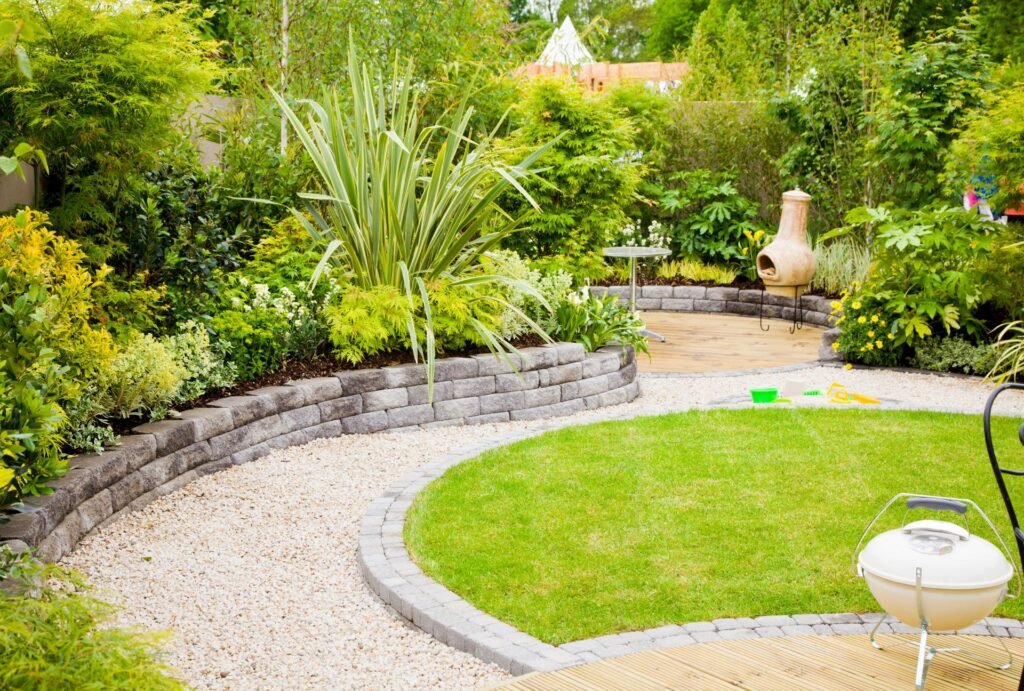
Sustainable Boundary Landscaping Ideas
Sustainable boundary landscaping not only looks good and provides structure to outdoor spaces but also helps the environment. By going green we can create functional, beautiful and eco friendly boundaries. Here are some practical design ideas for sustainable boundary landscaping that combines nature with design so your outdoor space is both functional and eco friendly.
Living Fences and Hedges
- Description: Living fences and hedges are a green alternative to traditional wooden or metal fences. They add visual appeal to your property and provide privacy and noise reduction. Living fences are made from a variety of plants, hedges, bamboo, climbing plants on trellises that grow together to form a barrier.
- Examples:
- Hedges: Hedges are a traditional choice for privacy and boundaries in a eco friendly way. Popular in New Zealand are native species like Pittosporum, Coprosma, or Griselinia which grow well in our climate and require minimal maintenance.
- Bamboo: Bamboo is another great option for a living fence. It grows fast, is durable and looks natural. Bamboo creates a sustainable boundary that grows taller and denser over time.
- Climbing Plants on Trellises: Using climbing plants like Clematis, Passionfruit or Wisteria on trellises is a beautiful solution for a living boundary. These plants can cover fences or walls and provide green coverage while supporting biodiversity by attracting pollinators.
- Benefits: Living fences provide privacy but also improve air quality, support local wildlife and add to the overall beauty of your property. Plus they can be a habitat for beneficial insects like bees and butterflies making them eco friendly.
Edible Boundaries
- Description: A new and sustainable way to boundary landscaping is to incorporate edible plants into your boundary design. Edible boundaries allows you to combine beauty with function by introducing fruit trees, herbs and vegetables that not only enhance your landscape but also provide fresh produce for your household.
- Examples:
- Fruit Trees: Fruit trees like apple, pear, plum or citrus are great for edible boundaries. They offer seasonal beauty with their blossoms and fruits and a harvest of fresh produce.
- Herbs: Low growing herbs like rosemary, thyme or mint can be planted along borders or in raised beds. These plants are easy to maintain, grow in many climates and provide culinary benefits.
- Vegetables: Edible vegetables like tomatoes, spinach or kale can be incorporated into boundary designs to create green walls that are beautiful and productive.
- Benefits: Edible boundaries offer two in one – beautiful landscaping and food production. They are a way to reduce your carbon footprint as you are growing your own food instead of buying from the store. Plus edible plants attract beneficial insects and biodiversity.
Permeable Pathways and Barriers
- Why: Sustainable boundary landscaping includes the use of permeable materials to allow natural drainage and reduce water runoff. Especially important in areas with heavy rainfall or poor drainage as it helps prevent erosion and supports water conservation.
- Permeable Pathway Ideas:
- Gravel: Gravel paths are a great option for permeable pathways. The gaps between the stones allow water to filter through and reduce runoff.
- Grass Pavers: Grass pavers or permeable pavers are designed to allow grass or ground cover to grow between the pavers, a pathway that is functional and beautiful. This option allows water to infiltrate while providing a solid surface.
- Wood Chips: Wood chips or mulch is another sustainable option for pathways. They decompose over time and enrich the soil while allowing rainwater to filter through. Wood chips are good for low traffic areas or alongside garden beds.
- Benefits: Permeable pathways and barriers protect your landscape from water damage and reduce the need for irrigation. They create a softer more natural look in your outdoor spaces and contribute to the health of your local ecosystem by preventing soil erosion and recharging groundwater.
Multifunctional Zones
- Description: Combining function with sustainability, multifunctional zones allows you to create outdoor spaces that serve more than one purpose. For example a boundary that is a privacy screen can also be designed to be a wildlife corridor or a seating area. These designs makes the most of the space and integrates privacy with ecological benefits.
- Examples:
- Wildlife Corridors: If you have a bigger property you can design your boundary to be a wildlife corridor, connecting different parts of your garden or neighbouring natural spaces. Using native plants to create a wildlife friendly boundary will attract local birds, insects and small animals and promote biodiversity.
- Seating and Shade: Multifunctional zones can also include seating areas or shaded spots as a relaxing retreat. A boundary can be combined with a seating area using natural stone or timber to create a peaceful space to enjoy the outdoors while still having privacy.
- Benefits: Multifunctional zones are efficient and sustainable, you can make the most of your outdoor space. By combining seating or shade with privacy and wildlife corridors you can create a harmonious diverse landscape that meets both practical and ecological needs.
Including these design ideas in your boundary landscaping not only enhances your property but also sustainability and environmental stewardship. Living fences, edible boundaries, permeable pathways and multifunctional zones allow you to create an eco friendly outdoor space that is functional, beautiful and beneficial to the ecosystem. Whether you want to reduce your carbon footprint or just create a more natural looking landscape these ideas are sustainable solutions for a healthier and more resilient environment.
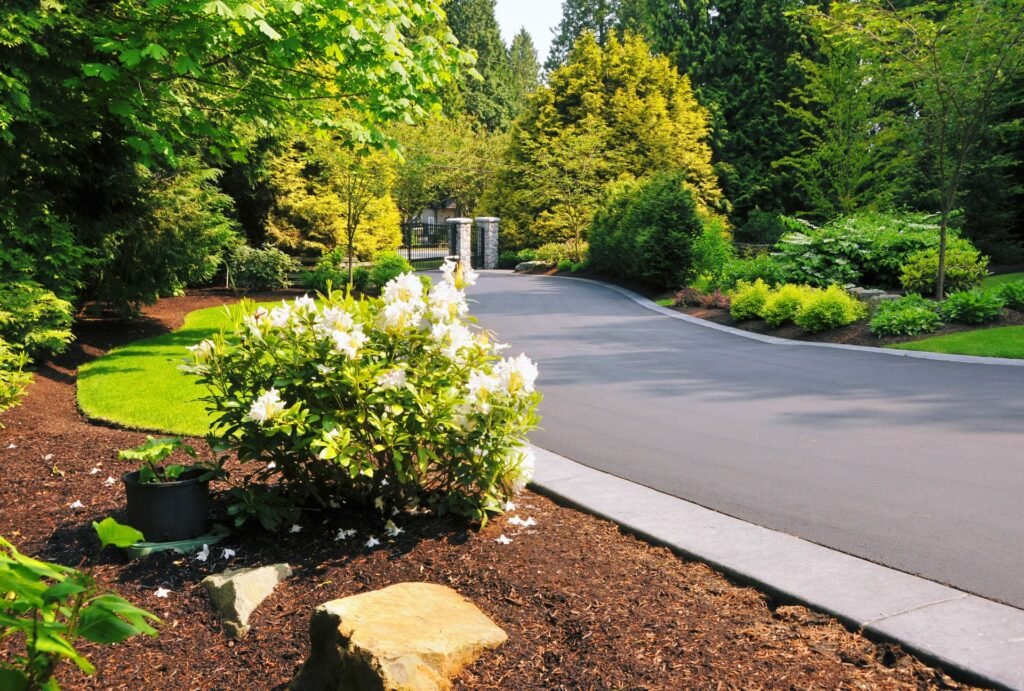
Common Issues And How To Fix Them
When it comes to boundary landscaping there are several issues that homeowners and gardeners face. From budget to maintenance it’s important to know these issues and how to manage them. Below we break down three of the most common issues and give you practical solutions to help you get past them.
Cost
One of the biggest issues many homeowners face when designing a boundary landscape is the cost of implementation. Landscaping projects especially those that involve boundary markers like fences, hedges or garden walls can seem daunting due to high upfront costs. Materials, labor and professional landscaping services can add up quickly especially if you’re going for an elaborate or high end design.
Solutions:
- Start Small: Instead of doing a full landscaping project all at once, start small. Focus on one section of the boundary or do it in phases. This way you can spread the cost over time and make adjustments as you go.
- Prioritize the Essentials: Identify the most important parts of your boundary landscaping, like a solid fence for privacy or a well maintained hedge for security. By prioritizing these you can allocate your budget effectively without sacrificing the overall look.
- DIY: There are many boundary landscaping elements you can do yourself, like planting low maintenance hedges, building small garden structures or painting a fence. DIY’s can save you on labor and materials. Just make sure to research proper techniques for a long lasting result.
Maintenance
Another issue with boundary landscaping is maintenance. Over time the plants, fences and other elements you’ve put in place will need upkeep to keep them healthy, functional and looking good. Some will need regular trimming like hedges, others will need occasional repairs like fences. This can be a big task especially for those who are busy.
Solutions:
- Low Maintenance Plants: Choose plants that are hardy and low maintenance. Native New Zealand species like flaxes or kawakawa are perfect for boundary landscaping as they thrive with minimal care and less water. Plus they add natural beauty and biodiversity to your landscape.
- Smart Irrigation: Installing a smart irrigation system can save you time and water. Drip irrigation for example delivers water straight to the roots, reducing evaporation and giving your plants just the right amount of water. This means a lush healthy landscape with minimal effort.
- Seasonal Care Tips: Each season brings its own set of maintenance needs. In summer your plants may need more water, in winter you may need to protect sensitive plants from frost. By staying on top of the seasons and planning your maintenance accordingly you can keep your boundary landscaping in top condition all year round.
Neighbors or Regulations
Boundary landscaping can sometimes cause conflicts with neighbors or breach local regulations. Issues can arise if the landscaping goes onto a neighbor’s property or doesn’t comply with zoning laws or building codes. This can lead to misunderstandings, legal disputes or fines.
Tips:
- Talk to Neighbors: Before you start any boundary landscaping project, talk to your neighbors. Open communication will ensure everyone is on the same page and prevent future disputes. Whether you’re putting up a fence, planting a hedge or building a garden wall, get their input early on and avoid problems.
- Follow Local Landscaping Rules: Every region has its own set of rules and regulations for boundary landscaping, like height restrictions for fences, plant species restrictions or zoning codes. Take the time to research local landscaping laws before you start your project. This will save you from unnecessary legal headaches and ensure your landscaping complies with all the rules.
By tackling these issues with these solutions you can have a beautiful, functional and sustainable boundary landscape that adds value to your property and your outdoor living space. Whether you’re managing costs, reducing maintenance or avoiding conflicts, these tips will get you the best results while keeping your neighbors happy and within the rules.
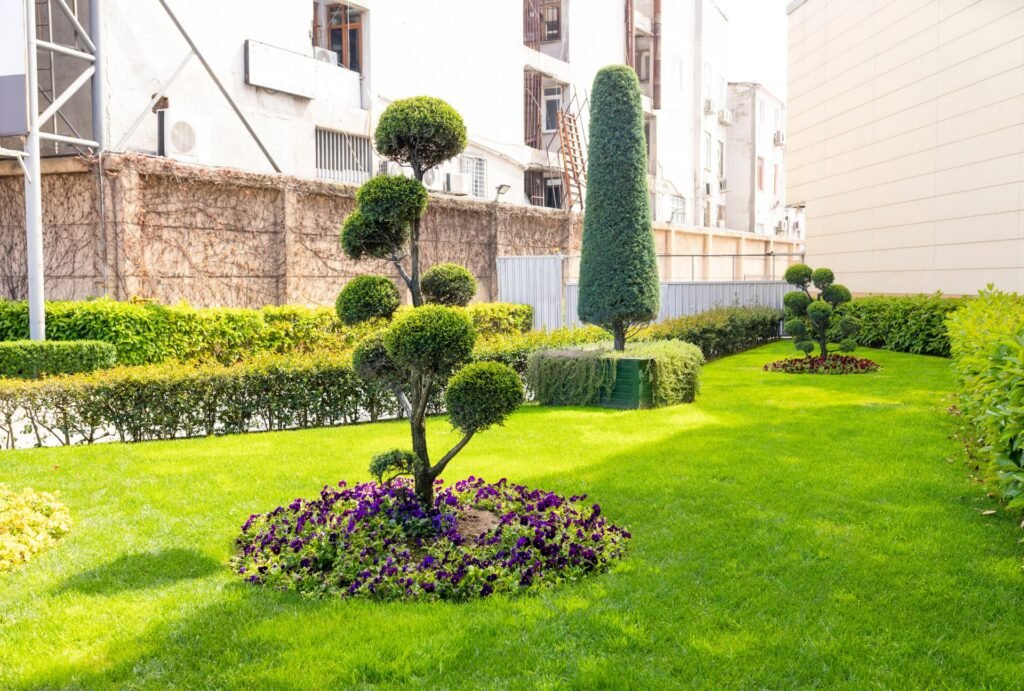
Long Term Boundary Landscaping Maintenance Practices
Boundary landscaping is a vital part of creating an outdoor space that looks and functions well and to ensure its long term success you need to adopt sustainable practices. Sustainable landscaping not only supports plant and soil health but also reduces environmental impact. Here are the key sustainable practices to ensure your boundary landscaping thrives for years to come:
Mulching and Soil Cover
Weed Control, Moisture Retention, Nutrient Cycling
Mulching is a fundamental sustainable practice that will improve your boundary landscaping over time. By applying organic materials such as wood chips, straw or compost to the soil surface you can create a layer that offers many benefits.
- Weed Control: Mulch acts as a barrier to prevent weed seeds from germinating so you don’t need to use nasty herbicides.
- Moisture Retention: The layer of mulch helps retain moisture in the soil so you don’t need to water as often, especially during dry periods. This is water efficient and saves energy used in irrigation systems.
- Nutrient Cycling: Organic mulches break down over time and add essential nutrients to the soil. As the mulch breaks down it returns valuable organic matter to the soil and supports boundary plant health and growth.
By mulching you are creating a more resilient and self sustaining garden that requires less intervention and maintenance over time.
Seasonal Care
Pruning, Planting Rotations, Pest Control Naturally
Long term boundary landscaping success is all about adjusting your care routines to the changing seasons. Seasonal care ensures plants are prepared for the environmental changes they face throughout the year. Here’s how to care for your landscapes year round:
- Pruning: Regular pruning keeps plants healthy by removing dead or diseased branches, improves air circulation and encourages new growth. In boundary landscaping proper pruning is also important for maintaining the shape and structure of hedges, shrubs and trees.
- Planting Rotations: If your boundary has vegetable gardens or flower beds, rotating plants seasonally will prevent soil depletion and reduce pest and disease buildup. Different plants have different nutrient requirements and rotating them ensures the soil remains fertile and healthy.
- Natural Pest Control: Instead of using chemical pesticides a sustainable approach encourages natural pest control methods. Beneficial insects like ladybugs and bees can control pests like aphids. Companion planting where certain plants are placed together to repel pests or promote healthy growth can reduce the need for nasty chemicals.
Seasonal care that suits your garden not only helps your plants thrive but also keeps the landscape looking and sustainable all year round.
Reusing Materials
Examples: Reused Wood for Edging, Recycled Stones for Paths
One of the most sustainable practices for boundary landscaping is reusing and repurposing materials. Instead of buying new materials consider reusing what you already have or salvaging what would otherwise go to waste.
- Reused Wood for Edging: Old wood from pallets, discarded furniture or reclaimed timber can be used to create beautiful rustic edging along garden beds or paths. Saves you money and prevents wood going to landfill.
- Recycled Stones for Paths: Stones from old patios, demolished buildings or even natural rocks on your property can be reused to create paths or borders. Reduces the demand for new stone and gravel and your carbon footprint and creates a more eco friendly landscape.
Reusing materials in your boundary landscaping makes the space unique and personal and reduces waste and conserves resources so it’s a true sustainable choice.
Monitoring and Adapting
Watch Plant Health and Soil Conditions Over Time
Sustainable landscaping requires ongoing attention to plant and soil health. Just planting and maintaining your landscape isn’t enough; watching and adjusting as needed ensures long term success.
- Plant Health: Monitor the health of your boundary plants regularly for signs of pests, disease or environmental stress. Early detection of problems allows you to address before they spread and reduces the need for nasty chemicals or unnecessary intervention.
- Soil Conditions: Over time soil conditions can change especially with mulching, seasonal watering and plant rotations. Occasional soil tests can help you understand nutrient levels and pH so your plants get the right care to thrive. Adding organic matter like compost can improve soil health and structure.
Adjusting to your landscape and adjusting your care over time means you can keep your boundary garden thriving and resource light.
Incorporating sustainable practices into your boundary landscaping not only benefits the environment but also creates a more resilient, cost effective and beautiful outdoor space. By using techniques like mulching, seasonal care, reusing materials and watching plant health you can keep your landscape healthy and sustainable for years to come. By doing so you’ll be supporting the long term success of your boundary landscaping and environmental stewardship and resource conservation.
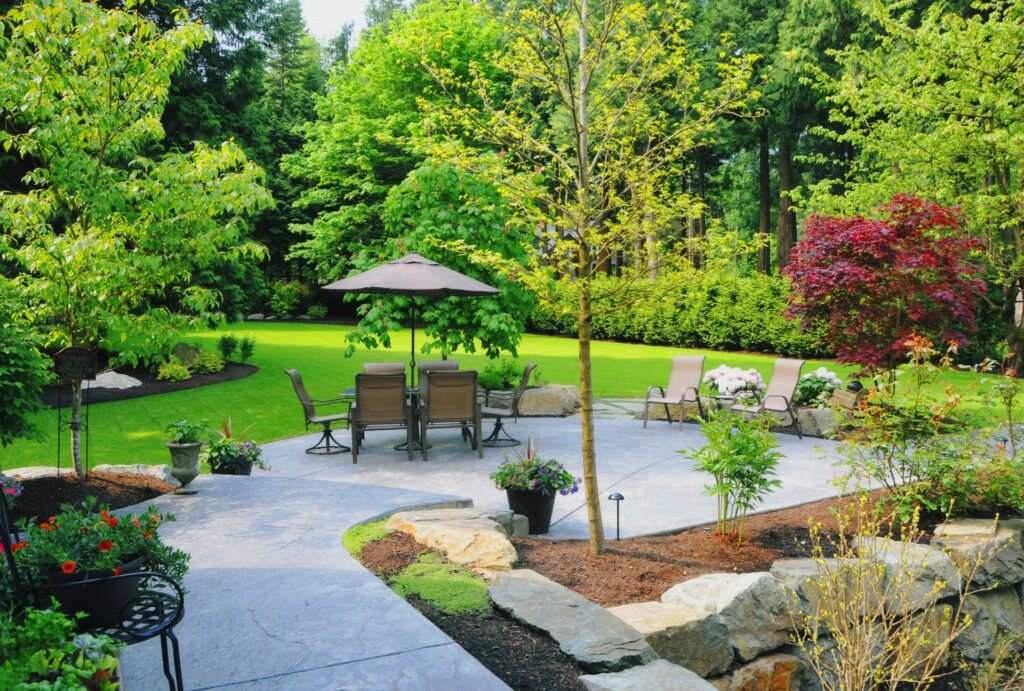
Real-Life Examples Of Boundary Landscaping
Boundary landscaping is important for both the environment and the property. In New Zealand where we live in the natural environment, sustainability in boundary landscaping is a big concern for homeowners and landowners. Here are two real-life examples.
Example 1: Small urban garden in Wellington with native hedges and edible plants
In the middle of Wellington one homeowner wanted to create a sustainable and low maintenance boundary while embracing the urban environment. The goal was to use native plants that would thrive in the local climate and provide ecological benefits. Native hedges were used as the boundary, Muehlenbeckia complexa (creeping wire vine) and Corokia cotoneaster (korokio) both are known for their hardiness, low water requirements and support local wildlife.
Alongside these hedges edible plants like kale, silverbeet and tomatoes were planted in raised garden beds creating a functional and productive border. The combination of native plants and edible crops provided privacy and security and aligned with the homeowner’s sustainability goals by reducing the carbon footprint of buying vegetables from the shop. The native hedges also provided habitat for local birds and insects and supported the wider ecosystem.
This shows how in an urban environment sustainable boundary landscaping can combine native plantings with practical benefits like food production. Using native plants in particular promotes biodiversity and conserves water – key elements of New Zealand’s overall environmental strategy.
- Visual Addition Suggestion: Images of native hedges Muehlenbeckia and raised garden beds with edible plants. Diagrams of how these were planted along the boundary.
Example 2: Rural property in Canterbury using layered windbreaks for sustainability and privacy
On a rural property in Canterbury boundary landscaping is more than just about looks – it’s about protecting the land from the strong winds that are a feature of the area. The homeowner used a layered windbreak to protect crops, reduce wind erosion and provide privacy. The windbreaks were multiple rows of trees and shrubs planted in a specific order to get the best results.
The outer layer of the windbreak was taller, more wind resistant trees like Pinus radiata (radiata pine) which formed a solid barrier to the wind. Behind this was a layer of smaller native shrubs, Hebes and Manuka (Leptospermum scoparium) to catch any wind that got through the first layer. These plants were chosen for their ability to thrive in the local soil and climate and provide habitat for birds and insects.
This boundary landscaping not only provided a windbreak but also supported sustainability by using local plants and biodiversity. The layered system with trees and shrubs reduced the need for artificial windbreaks or fencing and therefore the long term maintenance costs and environmental impact for the homeowner.
As well as these practical benefits the windbreaks created privacy and turned the property into a sheltered haven. By using multiple plant species the system also improved soil and water retention which is critical in Canterbury’s dry climate.
- Visual Addition Suggestion: Diagrams of the layered windbreak system. Photos of the property to show the open land and the sheltered area within the boundary.
These examples show how sustainable boundary landscaping can be applied to urban and rural environments in New Zealand. Whether it’s native hedges in Wellington or layered windbreaks in Canterbury, both demonstrate the plant power for ecological, aesthetic and practical benefits. By choosing the right plants homeowners can get privacy and security and be positive for the environment and local biodiversity.
- Visual Additions for the whole section: Images of real projects, before-and-after photos and detailed diagrams of planting layout. Diagrams of windbreaks or hedges and photos of urban garden and rural property to help the reader visualise the sustainable landscaping.
This content is educational and practical so the reader can gain a good understanding of sustainable boundary landscaping in New Zealand. The case studies and visual suggestions make it easier for the reader to apply this to their own property.
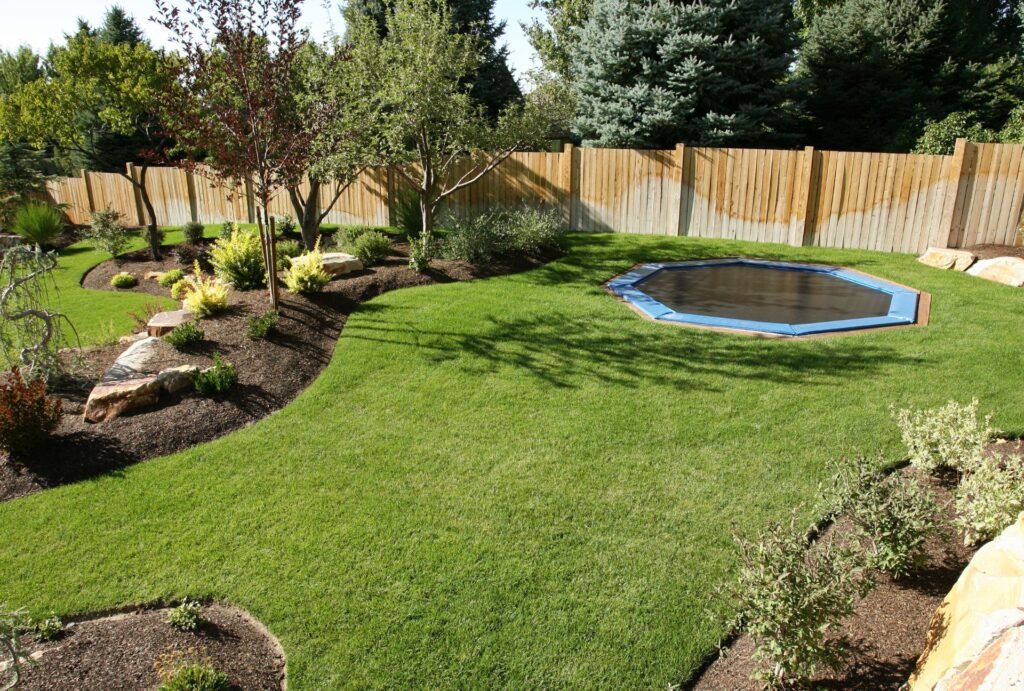
FAQs: About Sustainable Boundary Landscaping
What is sustainable boundary landscaping?
Sustainable boundary landscaping is an eco-friendly approach to designing and maintaining property borders that support biodiversity, conserve natural resources, and minimize environmental impact. It focuses on using native plants, efficient water management, and low-maintenance designs to create functional and beautiful outdoor spaces.
Why is sustainable boundary landscaping important?
This approach helps protect the environment by reducing water usage, promoting soil health, and supporting local ecosystems. It also offers long-term cost savings, enhances property aesthetics, and fosters harmony between neighbouring spaces.
What are some examples of plants suitable for sustainable boundary landscaping in New Zealand?
Native New Zealand plants such as kawakawa, harakeke (flax), manuka, and cabbage trees are excellent choices. These plants are well-adapted to local conditions, require minimal maintenance, and support native wildlife.
How can I conserve water in my boundary landscaping design?
You can conserve water by installing drip irrigation systems, using rainwater harvesting techniques, and selecting drought-tolerant plants. Mulching also helps retain soil moisture and reduces the need for frequent watering.
What are the benefits of using native plants in boundary landscaping?
Native plants require less water, are more resistant to local pests and diseases, and support native wildlife such as birds and pollinators. They also blend naturally with the surrounding environment, creating a cohesive and sustainable landscape.
How can I create a living fence for my property boundary?
A living fence can be created using hedges, climbing plants on trellises, or fast-growing species like bamboo. These options provide privacy, reduce noise, and enhance the ecological value of your boundary.
What challenges might I face with sustainable boundary landscaping?
Common challenges include initial setup costs, ongoing maintenance, and potential conflicts with neighbors or local regulations. These can be addressed by starting small, choosing low-maintenance designs, and maintaining open communication with stakeholders.
Can I incorporate edible plants into my boundary landscaping?
Yes, edible plants like fruit trees, berry bushes, and herbs can be integrated into your design. This not only enhances the functionality of your landscape but also provides a sustainable source of fresh produce.
How do I maintain a sustainable boundary landscape over time?
Regular maintenance includes mulching, pruning, seasonal planting, and monitoring soil health. Reusing materials like compost and recycled stones also helps maintain sustainability while reducing costs.
Is sustainable boundary landscaping suitable for small urban properties?
Absolutely! Even small urban properties can benefit from sustainable boundary landscaping. Compact designs using vertical gardens, potted plants, or narrow hedges can maximize the available space while still promoting eco-friendly principles.
Conclusion
Boundary landscaping that’s sustainable has so many benefits that go beyond just looking good. By using ecological practices like native plants and water wise design you’re supporting local biodiversity and reducing your environmental footprint. Plus these eco friendly choices often mean long term cost savings as they require less maintenance and replacement. If you’re thinking of a sustainable boundary project now is the time to start planning. Whether you’re thinking of a native garden, sustainable fencing or water smart solutions the options are endless. Let us know your thoughts and experiences! Leave a comment below.


